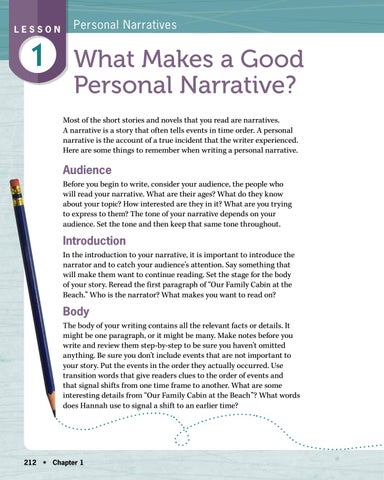LESSON
1
Personal Narratives
What Makes a Good Personal Narrative? Most of the short stories and novels that you read are narratives. A narrative is a story that often tells events in time order. A personal narrative is the account of a true incident that the writer experienced. Here are some things to remember when writing a personal narrative.
Audience Before you begin to write, consider your audience, the people who will read your narrative. What are their ages? What do they know about your topic? How interested are they in it? What are you trying to express to them? The tone of your narrative depends on your audience. Set the tone and then keep that same tone throughout.
Introduction In the introduction to your narrative, it is important to introduce the narrator and to catch your audience’s attention. Say something that will make them want to continue reading. Set the stage for the body of your story. Reread the first paragraph of “Our Family Cabin at the Beach.” Who is the narrator? What makes you want to read on?
Body The body of your writing contains all the relevant facts or details. It might be one paragraph, or it might be many. Make notes before you write and review them step-by-step to be sure you haven’t omitted anything. Be sure you don’t include events that are not important to your story. Put the events in the order they actually occurred. Use transition words that give readers clues to the order of events and that signal shifts from one time frame to another. What are some interesting details from “Our Family Cabin at the Beach”? What words does Hannah use to signal a shift to an earlier time?
212 • Chapter 1
